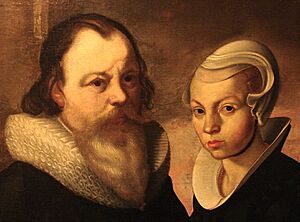Ole Worm facts for kids
Quick facts for kids
Ole Worm
|
|
|---|---|
 |
|
| Born | 13 May 1588 |
| Died | 31 August 1654 (aged 66) |
| Nationality | Danish |
| Other names | Olaus Wormius |
| Occupation | physician, natural historian and antiquary |
| Spouse(s) | Dorothea Fincke |
| Family | Christen Worm (grandson) |
Ole Worm (born May 13, 1588 – died August 31, 1654) was a famous Danish doctor, natural historian, and historian. He was also known by his Latin name, Olaus Wormius. Ole Worm taught at the University of Copenhagen. He was a professor of Greek, Latin, physics, and medicine.
Contents
About Ole Worm
Ole Worm was born in Aarhus, Denmark. His father, Willum Worm, was the mayor of Aarhus. Ole's grandfather, Johan Worm, was a judge who had moved from Arnhem to escape religious conflict.
Ole Worm married Dorothea Fincke. Her father, Thomas Fincke, was a well-known Danish mathematician and physicist. Thomas Fincke taught at the University of Copenhagen for over 60 years. He even created the math terms 'tangent' and 'secant'. Through this marriage, Ole Worm became connected to the powerful Bartholin family. This family included many doctors and scientists who were important at the University of Copenhagen for a long time.
Ole Worm loved learning. He went to grammar school in Aarhus. Then he studied theology at the University of Marburg in 1605. He earned his medical degree from the University of Basel in 1611. In 1617, he received a master's degree from the University of Copenhagen. He spent the rest of his career teaching in Copenhagen. He taught Latin, Greek, physics, and medicine. He also became the personal doctor for King Christian IV of Denmark.
Ole Worm showed great courage during an epidemic of the bubonic plague in Copenhagen. Unlike many doctors who left the city, he stayed to help the sick. Sadly, he caught the plague himself and died in 1654.
Contributions to Science
Ole Worm made important discoveries in many areas. He was a pioneer in both medicine and the study of ancient history.
Medical Discoveries
In medicine, Ole Worm's main work was in embryology, which is the study of how living things develop before birth. Small bones found in the skull are named after him. These are called Wormian bones. They are tiny bones that fill gaps in the skull's sutures.
Studying Ancient Runes
Ole Worm was very interested in old writings from Scandinavian countries. He collected many early books and papers written in these languages. He also wrote several books about runestones. Runestones are large stones with special ancient letters called runes carved into them. He gathered many texts written in runes. The King of Denmark even gave him letters to introduce him to bishops in Denmark and Norway. This shows how much the king supported Worm's work.
In 1626, Worm published a book called Fasti Danici (Danish Chronology). It shared his findings about runes. In 1636, he published Runir seu Danica literatura antiquissima (Runes: the oldest Danish literature). This book was a collection of copied runic texts. His book Danicorum Monumentorum (Danish Monuments) came out in 1643. This was the first written study of runestones. It is also one of the only remaining sources that show what many runestones and carvings from Denmark looked like. Some of these stones are now lost.
Observing Nature
Ole Worm was a scientist who used both old and new ways of thinking. For example, he used a very modern, evidence-based approach to study animals. In 1638, he proved that the unicorn was not a real animal. He showed that what people thought were unicorn horns were actually from the narwhal, a type of whale. However, he still wondered if narwhal horns had special powers, like protecting against poison. So, he did experiments by giving his pets small amounts of poison and then feeding them ground-up narwhal horn. He said his pets recovered, which he thought proved the horn's power.
He also did other important scientific studies. He showed clearly that lemmings are rodents. Before him, some people believed lemmings appeared out of thin air! He also made the first detailed drawing of a bird-of-paradise. This drawing proved that these birds do have feet, unlike what many people thought. Ole Worm mainly used his collection of natural objects to teach others.
His Amazing Museum
Ole Worm collected many interesting and unusual items. He created a famous collection called Museum Wormianum in Copenhagen. This collection included items from the New World, stuffed animals, and fossils. He thought a lot about what these fossils meant.
The Museum Wormianum was a special room filled with minerals, plants, animals, and objects made by people. After his death in 1654, a detailed catalog of his collection was published. This book, also called Museum Wormianum, included drawings of his collection and his ideas about them. The book was divided into four parts. The first three parts described minerals, plants, and animals. The fourth part focused on old archaeological finds and items from different cultures.
Gallery
-
Only known illustration of a great auk drawn from life
-
Worm's illustration of the Runamo inscription, wherein he asserted he could read the name Lund; the "inscription" later was found to be natural formations in the rock
See also
 In Spanish: Olaus Wormius para niños
In Spanish: Olaus Wormius para niños





